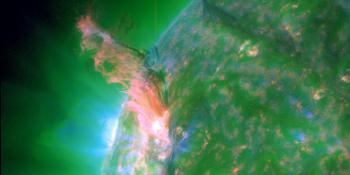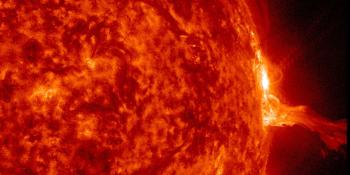Viewing archive of Wednesday, 21 May 2025
Daily bulletin on solar and geomagnetic activity from the SIDC
Issued: 2025 May 21 1231 UTC
SIDC Forecast
Solar flares
C-class flares expected, (probability >=50%)
Geomagnetism
Active conditions expected (A>=20 or K=4)
Solar protons
Quiet
| 10cm flux | Ap | |
|---|---|---|
| 21 May 2025 | 120 | 007 |
| 22 May 2025 | 122 | 015 |
| 23 May 2025 | 124 | 026 |
Solar Active Regions and flaring
Solar flaring activity over the last 24 hours has been moderate, with one M-class flare and a few C-class flares. The strongest flare was an M1.2 flare (SIDC Flare 4427) peaking at 00:08 UTC on May 21, associated with SIDC Sunspot Group 496 (NOAA Active Region 4087, magnetic type beta). There are currently eight numbered active regions on the solar disk. The most complex ones are five active regions with magnetic type beta. SIDC Sunspot Group 501 (NOAA active region 4091) has decayed into plage. SIDC Sunspot Group 504 (magnetic type beta) has emerged in the southwest quadrant. SIDC Sunspot Group 459 (magnetic type alpha) has rotated on disk from the east limb, in the northeast quadrant. Solar flaring activity is expected to be low over the next 24 hours, with C-class flares expected and a small chance for M-class flares.
Coronal mass ejections
A Coronal Mass Ejection (CME), SIDC CME 502, was observed in LASCO/C2 coronagraph imagery around 14:35 UTC on May 20, propagating to the west. It is likely a backsided event and it is not expected to impact Earth. A narrow CME (SIDC CME 501) was observed in LASCO/C2 coronagraph imagery around 20:00 UTC on May 20, lifting off the southeast quadrant. It is most likely associated with eruptive activity southwest of SIDC Sunspot Group 491 (NOAA Active Region 4092) and it is not expected to impact Earth. No other Earth-directed CMEs were observed in the available coronagraph imagery.
Coronal holes
The elongated, mid-latitude, positive polarity coronal hole (SIDC Coronal Hole 104) continues to cross the central meridian since May 15.
Solar wind
The solar wind conditions (ACE and DSCOVR) were enhanced during the past 24 hours, most likely due to the continuous influence of a high- speed stream from the southern, positive polarity coronal hole (SIDC Coronal Hole 104). The solar wind speed increased from 490 km/s to around 620 km/s. The interplanetary magnetic field values ranged from 5 nT to 10 nT. The Bz component ranged between -8 nT and 9 nT. The interplanetary magnetic field angle phi was predominantly in the positive sector. Further enhancements in the solar wind conditions may be expected over the next 24 hours, under the continuous influence of the high-speed stream from the southern, positive polarity coronal hole (SIDC Coronal Hole 104).
Geomagnetism
Geomagnetic conditions globally were mostly at unsettled levels (NOAA Kp 3) over the past 24 hours, reaching active levels (NOAA Kp 4) between 00:00 UTC and 03:00 UTC on May 21. Geomagnetic conditions locally were mostly at unsettled levels (K BEL 3), reaching active levels (K BEL 4) between 16:00 UTC and 17:00 UTC on May 20. Mostly unsettled to active levels, with a small chance for isolated minor storm intervals (NOAA Kp 3 to 5, K BEL 3 to 5), are expected over the next 24 hours, under the continuous influence of the high-speed stream from the southern, positive polarity coronal hole (SIDC Coronal Hole 104).
Proton flux levels
The greater than 10 MeV proton flux was below the 10 pfu threshold over the past 24 hours. It is expected to remain below the threshold level over the next 24 hours.
Electron fluxes at geostationary orbit
The greater than 2 MeV electron flux measured by GOES 18 was over the 1000 pfu threshold between 18:00 UTC on May 20 and 00:00 UTC on May 21. The greater than 2 MeV electron flux measured by GOES 19 was close to the 1000 pfu threshold but remained below it in the past 24 hours. The greater than 2 MeV electron flux is expected to be above the 1000 pfu threshold over the next 24 hours. The 24-hour electron fluence is presently at normal levels and is expected to remain so over the next 24 hours.
Today's estimated international sunspot number (ISN): 103, based on 19 stations.Solar indices for 20 May 2025
| Wolf number Catania | 110 |
| 10cm solar flux | 119 |
| AK Chambon La Forêt | 026 |
| AK Wingst | 014 |
| Estimated Ap | 016 |
| Estimated international sunspot number | 082 - Based on 29 stations |
Noticeable events summary
| Day | Begin | Max | End | Loc | Strength | OP | 10cm | Catania/NOAA | Radio burst types |
|---|---|---|---|---|---|---|---|---|---|
| 21 | 0001 | 0008 | 0010 | N18W21 | M1.2 | SN | 69/4087 |
Provided by the Solar Influences Data analysis Center© - SIDC - Processed by SpaceWeatherLive
All times in UTC
Latest news
Latest forum messages
Support SpaceWeatherLive.com!
A lot of people come to SpaceWeatherLive to follow the Sun's activity or if there is aurora to be seen, but with more traffic comes higher server costs. Consider a donation if you enjoy SpaceWeatherLive so we can keep the website online!

Space weather facts
| Last X-flare | 2025/05/14 | X2.7 |
| Last M-flare | 2025/05/21 | M1.2 |
| Last geomagnetic storm | 2025/05/17 | Kp6+ (G2) |
| Spotless days | |
|---|---|
| Last spotless day | 2022/06/08 |
| Monthly mean Sunspot Number | |
|---|---|
| April 2025 | 140.6 +6.4 |
| May 2025 | 69.6 -71 |
| Last 30 days | 86.9 -26 |


